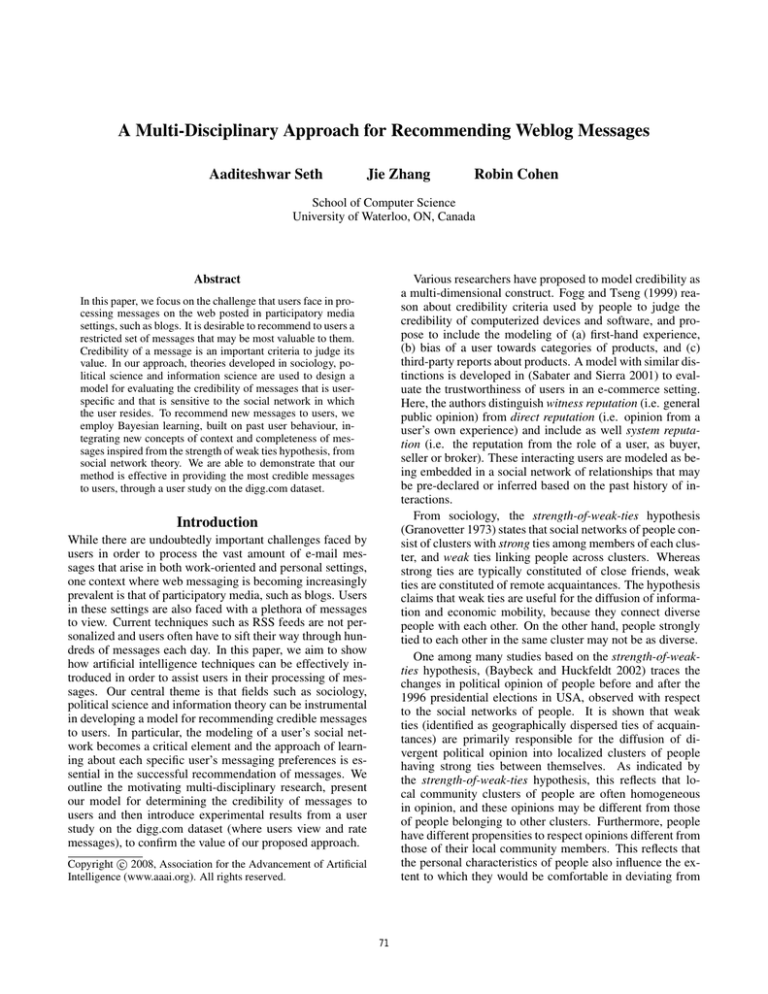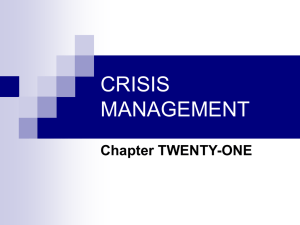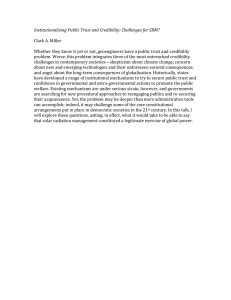
A Multi-Disciplinary Approach for Recommending Weblog Messages
Aaditeshwar Seth
Jie Zhang
Robin Cohen
School of Computer Science
University of Waterloo, ON, Canada
Abstract
Various researchers have proposed to model credibility as
a multi-dimensional construct. Fogg and Tseng (1999) reason about credibility criteria used by people to judge the
credibility of computerized devices and software, and propose to include the modeling of (a) first-hand experience,
(b) bias of a user towards categories of products, and (c)
third-party reports about products. A model with similar distinctions is developed in (Sabater and Sierra 2001) to evaluate the trustworthiness of users in an e-commerce setting.
Here, the authors distinguish witness reputation (i.e. general
public opinion) from direct reputation (i.e. opinion from a
user’s own experience) and include as well system reputation (i.e. the reputation from the role of a user, as buyer,
seller or broker). These interacting users are modeled as being embedded in a social network of relationships that may
be pre-declared or inferred based on the past history of interactions.
From sociology, the strength-of-weak-ties hypothesis
(Granovetter 1973) states that social networks of people consist of clusters with strong ties among members of each cluster, and weak ties linking people across clusters. Whereas
strong ties are typically constituted of close friends, weak
ties are constituted of remote acquaintances. The hypothesis
claims that weak ties are useful for the diffusion of information and economic mobility, because they connect diverse
people with each other. On the other hand, people strongly
tied to each other in the same cluster may not be as diverse.
One among many studies based on the strength-of-weakties hypothesis, (Baybeck and Huckfeldt 2002) traces the
changes in political opinion of people before and after the
1996 presidential elections in USA, observed with respect
to the social networks of people. It is shown that weak
ties (identified as geographically dispersed ties of acquaintances) are primarily responsible for the diffusion of divergent political opinion into localized clusters of people
having strong ties between themselves. As indicated by
the strength-of-weak-ties hypothesis, this reflects that local community clusters of people are often homogeneous
in opinion, and these opinions may be different from those
of people belonging to other clusters. Furthermore, people
have different propensities to respect opinions different from
those of their local community members. This reflects that
the personal characteristics of people also influence the extent to which they would be comfortable in deviating from
In this paper, we focus on the challenge that users face in processing messages on the web posted in participatory media
settings, such as blogs. It is desirable to recommend to users a
restricted set of messages that may be most valuable to them.
Credibility of a message is an important criteria to judge its
value. In our approach, theories developed in sociology, political science and information science are used to design a
model for evaluating the credibility of messages that is userspecific and that is sensitive to the social network in which
the user resides. To recommend new messages to users, we
employ Bayesian learning, built on past user behaviour, integrating new concepts of context and completeness of messages inspired from the strength of weak ties hypothesis, from
social network theory. We are able to demonstrate that our
method is effective in providing the most credible messages
to users, through a user study on the digg.com dataset.
Introduction
While there are undoubtedly important challenges faced by
users in order to process the vast amount of e-mail messages that arise in both work-oriented and personal settings,
one context where web messaging is becoming increasingly
prevalent is that of participatory media, such as blogs. Users
in these settings are also faced with a plethora of messages
to view. Current techniques such as RSS feeds are not personalized and users often have to sift their way through hundreds of messages each day. In this paper, we aim to show
how artificial intelligence techniques can be effectively introduced in order to assist users in their processing of messages. Our central theme is that fields such as sociology,
political science and information theory can be instrumental
in developing a model for recommending credible messages
to users. In particular, the modeling of a user’s social network becomes a critical element and the approach of learning about each specific user’s messaging preferences is essential in the successful recommendation of messages. We
outline the motivating multi-disciplinary research, present
our model for determining the credibility of messages to
users and then introduce experimental results from a user
study on the digg.com dataset (where users view and rate
messages), to confirm the value of our proposed approach.
c 2008, Association for the Advancement of Artificial
Copyright Intelligence (www.aaai.org). All rights reserved.
71
different clusters. We use Vit to denote the local cluster
of users strongly tied to user ui with respect to topic t.
C=Credibility
=Credibility
CN=Contextual
S=Cluster
L=Role
CM=Completeness
E=Experienced
These assumptions are reasonable in contexts such as the
website digg.com, which allows users to construct social
networks by declaring some users as their friends. Information about message authorship and ratings given by users
to messages is also available. We will show that we can use
this knowledge to quantify different types of credibilities for
each message with respect to each user. Then, based on ratings given by a particular user to older messages, we can use
a Bayesian model to learn preferences of the user towards
these different kinds of credibilities of messages. Finally,
we can use this learned model to predict whether or not the
new message mk will be considered credible by user ui .
P=Public
Figure 1: Credibility model
the beliefs of their immediate local cluster.
From these studies, we learn that (a) there is value to look
at the special case of third-party reporting within a user’s
cluster or local community, and (b) it is important to allow
users to have different weights on the importance of different
types of credibilities. Note that this last insight is reinforced
by studies in information science (Rieh 2002), which argue
that users have different preferences for different types of
credibilities discussed so far. Inspired by these studies, we
develop and operationalize a multi-dimensional subjective
credibility model for participatory media as described next.
Bayesian network: The different types of credibilities
that we choose to model are as follows:
• eikt = experienced credibility: This is based only on ratings given by user ui in the past, and denotes the credibility that ui associates with the message mk written by uj ,
based on ui ’s self belief about uj .
• likt = role based credibility: This denotes the credibility
that ui associates with the message mk written by users
having the same role as that of uj ; for example, based on
whether the messages’ authors are students, or professors,
or journalists, etc.
Bayesian User Model
Knowledge assumptions: Suppose that we wish to predict whether a message mk about a topic t and written by
user uj , will be considered credible by user ui . We assume
that we have the following prior knowledge:
• sikt = cluster credibility: This is based on the ratings
given by other users in cluster Vit , that is, the cluster of
user ui . It denotes the credibility associated by the cluster or local community of ui to the message mk written
by uj , based on the belief of the members of the cluster
about mk .
• We consider a scenario where all older messages about
topic t written in the past are labeled with the author
of each message. In addition, a message may have also
been assigned ratings by various recipient users, whenever users would have read the message, based on the
credibility of the message for the recipient. The set of
credibility ratings of any message are also assumed to be
available 1 .
• pkt = public credibility: This is based on ratings by all the
users, and reflects the public opinion about the credibility
for the message mk written by uj .
• Users may declare a subset of other users as their
“friends”. We refer to an explicitly declared relationship
between two users as a link between them, and assume to
have knowledge of the social network graph formed by all
users and the links between pairs of users.
Each of these credibilities can be expressed as a real
number ∈ [0, 1], and we propose a Bayesian network to
combine them into a single credibility score. The model
is shown in Fig. 1. Our aim is to learn the distribution
for Pit (C|E,L,S,P) for each user and topic based on ratings
given by various users to older messages; here, {E,L,S,P}
are evidence variables for the four types of credibilities for
a message, and C is a variable denoting the credibility that
ui associates with the message. Thus, for each topic t, a
set of messages M about t will be used during the training
phase with samples of (cik , eik , lik , sik , pk ) for different
messages mk ∈ M to learn the topic specific credibility
models for ui . Assuming that a user’s behavior with respect to preferences for different kinds of credibilities remains consistent over time, the learned model can now be
used to predict cix for a new message mx about topic t, that
is, Pit (cix |eix , lix , six , px ). We also introduce two hidden
variables, to help make the model more tractable to learn,
and to capture insights about messages that we developed in
prior work (Seth and Zhang 2008) – context and completeness, defined as follows:
• Users may also declare topics of interest to them. We use
this information, and the social network graph, to derive
the topic specific social network graph for topic t, as the
induced subgraph of the overall social network graph consisting only of those users and edges between users who
are interested in topic t.
• For each topic specific social network graph, community
identification algorithms such as (Dongen 2000) can identify dense clusters of users and links. We use the definition of strong and weak ties proposed by (Granovetter
1973), and refer to strong ties as links between users in
the same cluster, and weak ties as links between users in
1
We also assume that we are beyond the cold-start stage so that
the set of older messages have all received some ratings, and all
users have provided at least some ratings.
72
• Context relates to the ease of understanding of the message, based on how well the message content explains the
relationship of the message to its recipient. Simplification of the meaning of the message (Bryant and Zillman
2002), can be considered as an outcome of the amount of
context in the message. That is, messages that are more
contextual for users, will be more simple for them to understand.
• Completeness denotes the depth and breadth of topics
covered in the message. The scope of the message, or the
opinion diversity expressed in the message (Bryant and
Zillman 2002), can be considered as outcomes of the degree of completeness of the message. That is, messages
that are more complete will carry more diverse opinions
or more mention of relationships with other issues.
Note that the Bayesian model is hierarchical: For each
message, the model first estimates the credibilities of the
contextual and complete information carried by the message, and then uses these two credibilities to generate the
final estimate. Context is learned on the basis of cluster, role
and experienced credibilities; completeness is learned on the
basis of role, experienced and public credibilities.
Note as well that our modeling method has some interesting design features: the model takes into account personal
and contextual opinions of people that may influence their
credibility judgements; the model is learned in a personalized manner for each user, and allows accommodating varying degrees of propensities of users to respect opinions of
other users; different model instances are learned for different topics, making credibility judgements topic-specific.
We will show in the next section that a fourth feature of allowing mistakes by credible users and useful messages by
non-credible users can also be modeled in this framework.
• N[n,n]: A social network matrix where nij ∈ {0, 1} indicates the presence or absence of a link from user ui to
user uj . We also assume that the clustering algorithm can
identify clusters of strong ties among users, connected to
other clusters through weak ties.
Our goal is to find a method to compute the evidence variables for the Bayesian model using the axioms given above.
The evidence variables can be expressed as the matrices
E[n,k], L[n,k], S[n,k], and P[k], containing the credibility values for messages. Here, pk is the public credibility for
message mk authored by user uj . eij and lij are the experienced and role based credibilities respectively for message
mk according to the self-beliefs of user ui . Similarly, sij
is the cluster credibility for message mk according to the
beliefs of the users in ui ’s cluster Vi . Once these evidence
variables are computed for older messages, they are used to
learn the Bayesian model for each user. Subsequently, for a
new message, the learned model for a user is used to predict
the credibility of the new message for the user. We begin
with computation of the evidence variable matrix for public credibility P; we will explain later how other credibilities
can be computed in a similar fashion.
1. Let P0 [n] be a matrix containing the public credibilities
of users, and consider the credibility of a message as the
mean of the ratings for the message, weighted by the credibility of the raters (A-1):
X
pk =
rki .p0i /|rki > 0|
i
This is the same as writing P=Rr .P0 , where Rr is the rowstochastic form of R, ie. the sum of elements of each row
= 1.
2. The credibility of users is calculated as follows:
2a. Consider the credibility of a user as the mean of the credibilities of the messages written by her (A-2):
X
p0i =
pk /|pk |
Credibility Computation
We begin with the following axioms:
• A-1: A message is credible if it is rated highly by credible
users.
• A-2: A user is credible if messages written by her are rated
highly by other credible users.
• A-3: A user is also credible if ratings given by her are
credible, that is, she gives high ratings to messages that
appear to be credible to credible users, and low ratings to
messages that appear to be non-credible.
• A-4: A user is also credible if she is linked to by other
credible users in the social network.
We henceforth assume that we are operating within some
topic t, and drop the subscript for simplicity. We begin with
the following information:
• A[k,n]: A matrix for k messages and n users, where aij ∈
{0, 1} indicates whether message mi was written by uj
• R[k,n]: A ratings matrix for k messages and n users,
where rij ∈ {0, 1} 2 indicates the rating given to message mi by user uj
k
This is the same as writing P0 =ATc .P, where Ac is the
column-stochastic form of A; and ATc is the transpose of
Ac .
2b. The above formulation indicates a fixed point computation:
P0 =ATc .Rr .P0
(1)
0
Thus, P can be computed as the dominant Eigenvector
of ATc .Rr . This formulation models the first two axioms,
but not yet the ratings-based credibility (A-3) and social
network structure of the users (A-4). This is done as explained next.
2c. Perform a fixed-point computation to infer the credibilities G[n] acquired by users from the social network (A-4):
G=(β.NTr + (1-β).Zc .1T ).G
(2)
Here, β ∈ (0, 1) denotes a weighting factor to combine
the social network matrix N with the matrix Z that carries information about ratings given to messages by users.
2
We assume in this paper that the ratings are binary. However,
our method can be easily generalized to real-valued ratings as well.
73
We generate Z by computing zi as the mean similarity
in credibility ratings of user ui with all other users. The
ratings similarity between a pair of users is computed as
the Jacquard’s coefficient of common ratings between the
users. Thus, zi will be high for users who give credible
ratings, that is, their ratings agree with the ratings of other
users (A-3). In this way, combining the social-network
matrix with ratings-based credibility helps to model the
two remaining axioms as well. Note that Zc [n] is a column stochastic matrix and 1[n] is a unit column matrix;
augmenting N with Zc .1T provides an additional benefit of converting N into an irreducible matrix so that its
Eigenvector can be computed 3
Model learning: Once the various types of credibilities
for messages are calculated with respect to different users,
this training data is used to learn the Bayesian model
for each user and topic of interest to the user using the
Expectation-Maximization (EM) algorithm. The model parameters are learned to predict for user ui interested in topic
t, the probability Pit (cix |eix , six , px ) that ui will find a new
message mx to be credible.
Inference: Now, for a new message mx , the evidence variables are calculated with respect to a recipient user ui in one
of two ways as described next, and the learned model is used
to produce a probabilistic prediction of whether ui would
find mx to be credible.
2d. The ratings and social network based scores are then combined together as:
P0 =(α.ATc .Rr + (1-α).Gc .1T ).P0
• Authorship: The four types of credibilities of the message
are considered to be the same as the corresponding four
types of credibilities of its author with respect to ui .
(3)
• Ratings: The cluster and public credibilities are calculated
as the weighted mean of ratings for the message given by
other users and the credibilities of these users with respect
to ui . The experienced and role based credibilities are
the same as the corresponding credibilities of the message
author with respect to ui .
Here again 1 is a unit column matrix, and α ∈ (0, 1) is a
weighting factor. The matrix P0 can now be computed as
the dominant Eigenvector using the power method.
3. Once P0 is obtained, P is calculated in a straightforward
manner as P=Rr .P0 .
The processes to compute cluster S[n,k], experienced
E[n,k], and role based L[n,k] credibilities are identical, except that different cluster credibilities are calculated with
respect to each cluster in the social network, and different
experienced and role based credibilities are calculated with
respect to each user.
The cluster credibilities S[n,k] are computed in the same
manner as the public credibilities, but after modifying the
ratings matrix R to contain only the ratings of members of
the same cluster. Thus, the above process is repeated for
each cluster, modifying R in every case. For each users ui
belonging to cluster Vi , sik is then equal to the cluster credibility value for message mk with respect to ui . The matrix
Z in the computation on the social network matrix is also
modified. When computing the cluster credibilities for cluster Vi , element zj of Z is calculated as the mean similarity
of user uj with users in cluster Vi . Thus, zj will be high
for users who are regarded credible by members of cluster
Vi because their ratings agree with the ratings of the cluster
members.
The experienced credibilities E[n,k] are computed in the
same manner as well, but this time for each user by modifying the ratings matrix R to contain only the ratings given by
the user. The matrix Z is also modified each time by considering zj as the similarity between users ui and uj , when
calculating the experienced credibilities for ui .
Role based credibility is computed as the mean experienced credibilities of users having the same role. However,
we do not use role based credibility in our evaluation because sufficient user profile information was not available in
the digg dataset used by us. Henceforth, we ignore L[n,k]
in our computations.
As we will show in the evaluation, the ratings method performs better than the authorship method. This allows new
users to popularize useful messages written by them because
their own credibility does not play a role in the computations. It also allows credible users to make mistakes because
the credibility of the author is not taken into account. Given
the evidence variables for the new message, and the learned
Bayesian model, the probability of ui finding the message
to be credible is computed using standard belief propagation
methods such as Markov-Chain-Monte-Carlo (MCMC).
Evaluation
We evaluate our method over a dataset of ratings by real
users obtained from a popular knowledge sharing website,
digg.com (Lerman 2007). The website allows users to submit links to news articles or blogs, which are called stories
in the terminology used by the website. Other users can vote
for these stories; this is known as digging the stories. Stories
that are dugg by a large number of users are promoted to the
front-page of the website. In addition, users are allowed to
link to other users in the social network. Thus, the dataset
provides us with all the information we need:
• Social network of users: We use this information to
construct the social network link matrix between users
N[n,n]. The social network is clustered using MCL,
a flow-stochastic graph clustering algorithm (Dongen
2000), to produce classifications of ties as strong or weak
The cluster of users strongly connected to user ui is referred to as Vi .
• Stories submitted by various users: We use this information to construct the authorship matrix A[k,n]. Since all
the stories in the dataset were related to technology, we
consider all the stories as belonging to a single topic.
3
This step is similar to the Pagerank computation for the importance of Internet web pages (Brin and Page 2001).
74
(tp .tn − fp .fn )
(tp + fp )(tp + fn )(tn + fp )(tn + fn )
• Stories dugg by various users: We use this information to
construct the ratings matrix R[k,n]. We consider a vote of
1 as an evidence for credibility of the story, and a vote of
0 as an evidence of non-credibility.
Although the dataset is quite large with over 200 stories,
we are able to use only 85 stories which have a sufficiently
large number of ratings by a common set of users. This is because we require the same users to rate many stories so that
we have enough data to construct training and test datasets
for these users. Eventually, we assemble a dataset of 85 stories with ratings by 27 users. We do not include users who
rate more than 65 stories as all credible or all non-credible,
because a good predictor for such users would be to always
return 1 or 0, and besides, such user behavior may amount
to attacks on the system which we consider as future work.
A few assumptions we make about the validity of the dataset
for our experiments are as follows:
• The submission of a story to Digg may not necessarily
be made by the author of the story. However, we regard
the submitting user as the message author because it distinguishes this user from other users who only provide
further ratings to the messages.
• The ratings provided on the Digg website may not reflect credibility ratings, but rather usefulness ratings given
to messages by users. We however consider them to be
equivalent to credibility because of the smaller dataset
size we use. We argue that since the users in the dataset
vote for at least 20 stories out of 85 (25% of the total number of stories), they are likely to be interested in the topic
and all the stories; therefore, the only reason for their not
voting for a story would be its credibility.
We use an open-source package, OpenBayes, to program
the Bayesian network. We simplify the model by discretizing the evidence variables E,S,P into 3 states, and a binary
classification for the hidden variables N, M, and the credibility variable C. The discretization of the evidence variables into 3 states is performed by observing the Cumulative Distribution Frequency (CDF) and Complementary
CDF (CCDF) of each variable with respect to the credibility
rating of users. The lower cutoff is chosen such that the
product of the CDF for rating=0 and CCDF for rating=1
is maximum, and the upper cutoff is chosen such that the
CCDF for rating=0 and CDF for rating=1 is maximum. This
gives a high discrimination ability to the classifier because
the cutoffs are selected to maximize the pair-wise correlation
of each evidence variable with the credibility rating given by
the user.
MCC = p
Here, fp = false positives, tp = true positives, fn = false
negatives, tn = true negatives. The MCC is a convenient
measure because it gives a single metric for the quality of
binary classifications.
• TPR-FPR: This plots on an XY-scale the true positive rate
(TPR) with the false positive rate (FPR) of a binary classification. The point of maximum accuracy is TPR=1.0 and
FPR=0.0, and the random baseline is TPR=FPR. Therefore, points above the random baseline are considered to
be good.
All experiments are performed with α = 0.5 (eqn. 3) and
β = 0.85 (eqn. 2), which was the best choice of parameters, and also convey our message that all of authorship, ratings, and social networks provide valuable credibility information.
Figure 2: Performance of Bayesian credibility model
Inference methods: Fig. 2 shows the TPR-FPR plot for
ratings and authorship based evidence variable computation
when α = 0.5 and β = 0.85. As can be seen visually, the
ratings-based method performs better than the authorshipbased method. The former gives MCC = 0.156 (σ=0.073),
while the latter gives MCC = 0.116 (σ=0.068). However,
the authorship performance is still successful for a majority,
which is encouraging. This indicates that authorship information may be used to solve the problem of cold-start for
new messages that have not acquired a sufficient number of
ratings. Similarly, ratings may be used to solve cold-start for
new authors who have not acquired sufficient credibility.
We notice that the classifier performs very well for some
users, but close to random for some other users. To understand this further, we computed the variance of cluster and
experienced credibility scores for different users and found
that more the discrimination produced in the cluster and experienced credibility scores by a user, the better the performance of the user. It therefore seems that greater discrimination ability implies higher entropy in the information theoretic sense, leading to better prediction capability. This is an
interesting result that we plan to investigate further in the future to understand the sensitivities of our model to different
Metrics: We evaluate the performance of the model for
each user by dividing the 85 stories into a training set of
67 stories and a test set of 17 stories (80% and 20% of the
dataset respectively). We then repeat the process 20 times
with different random selections of stories to get confidence
bounds for the cross validation. For each evaluation, we
use two kinds of performance metrics (Davis and Goadrich
2006):
• Matthew’s correlation coefficient: This is computed as
follows:
75
Dongen, S. 2000. MCL: A Cluster Algorithm for Graphs.
PhD Thesis, University of Utrecht.
Granovetter, M. 1973. The strength of weak ties. American
Journal of Sociology 78(6).
Kamvar, S.; Scholsser, M.; and Garcia-Molina, H. 2003.
The eigentrust algorithm for reputation management in p2p
networks. In Proceedings of WWW.
Lerman, K. 2007. Social information processing in news
aggregation. IEEE Internet Computing 11(6).
Rieh, S. 2002. Judgement of information quality and cognitive authority on the web. Information Science and Technology 53(2).
Sabater, J., and Sierra, C. 2001. Regret: A reputation
model for gregarious societies. In Proceedings of the Fifth
International Conference on Autonomous Agents Workshop on Deception, Fraud and Trust in Agent Societies,
61–69.
Seth, A., and Zhang, J. 2008. A social network based
approach to personalized recommendation of participatory
media content. In Proceedings of ICWSM.
Whitby, A.; Jøsang, A.; and Indulska, J. 2005. Filtering out
unfair ratings in bayesian reputation systems. The Icfain
Journal of Management Research 48–64.
distributions of input matrices.
Comparison: We next compare our method with other
well known methods for trust and reputation computation
meant for different applications. All these methods perform
very close to random, even with personalization. We believe
this to be due to a fundamental drawback of these methods:
they try to form an objective assessment of credibility for
users and messages, which is not appropriate for participatory media.
• An Eigenvector computation on ATc .Rr by leaving out the
social network part (eqn. 1), is identical to the Eigentrust
algorithm (Kamvar, Scholsser, and Garcia-Molina 2003).
The best choice of parameters could only give a performance of MCC = -0.015 (σ = 0.062). Eigentrust has primarily been shown to work in P2P file sharing scenarios
to detect malicious users that inject viruses or corrupted
data into the network. However, the P2P context requires
an objective assessment of the trustworthiness of a user,
and does not allow for subjective differences, as desired
for participatory media.
• An Eigenvector computation on the social network matrix
(eqn. 2), personalized for each user, is identical to the
Pagerank algorithm used to rank Internet web pages (Brin
and Page 2001). However, this too performs poorly with
an MCC = 0.007 (σ = 0.017). This suggests that users are
influenced not only by their own experiences, but also by
the judgement of other users in their cluster, and by public
opinion. Methods ignoring these factors may not perform
well.
• The beta-reputation system (Whitby, Jøsang, and Indulska
2005) is used in e-commerce environments to detect good
or bad buying and selling agents. It estimates the credibility of agents in an objective manner using a probabilistic model based on the beta probability density function.
Only the public opinion is considered; ratings are filtered
out if they are not in the majority amongst other ratings. It
too does not perform well in the context of participatory
media, giving an MCC = 0.064 (σ = 0.062).
Our conclusion is that approaches which subjectively
model credibility, allowing users to be influenced in different ways by different sources, perform better than objective
modeling approaches.
References
Baybeck, B., and Huckfeldt, R. 2002. Urban contexts,
spatially dispersed networks, and the diffusion of political
information. Political Geography 21.
Brin, S., and Page, L. 2001. The pagerank citation
ranking: Bringing order to the web. Technical Report http://dbpubs.stanford.edu:8090/pub/1999-66, Technical Report.
Bryant, J., and Zillman, D. 2002. Media Effects: Advances
in Theory and Research. Lawrence Erlbaum Associates.
Davis, J., and Goadrich, M. 2006. The relationship between precision-recall and roc curves. In Proceedings of
ICML,.
76








